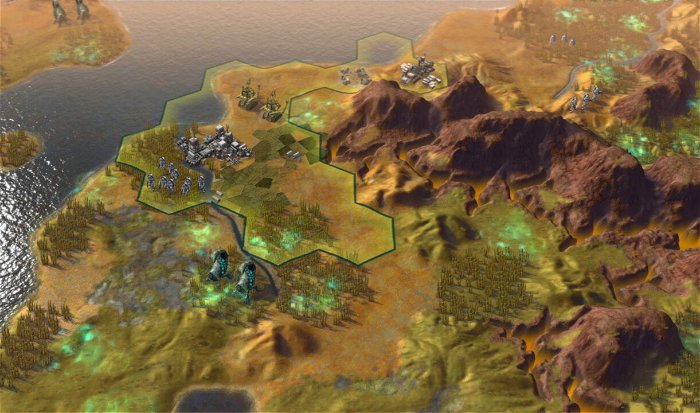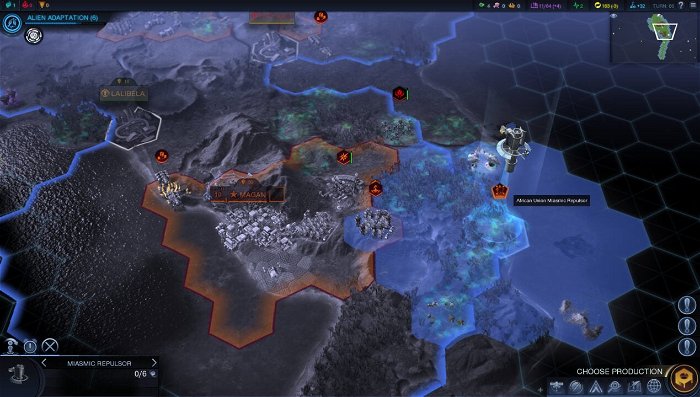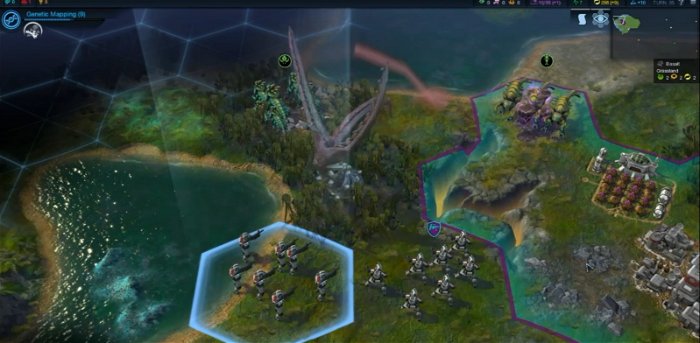As tired a phrase as it is, space really is the final frontier. Where humanity used to find adventure and knowledge in pushing against the boundaries of our own planet’s wilderness, now there’s very little we haven’t seen lurking in Earth’s seas, jungles, and mountains. Outer space, though, is still a largely mysterious place where just about anything seems possible. Because we’re not yet capable of exploring its expanses, space instils a kind of deep wonder that our planet doesn’t always match. Firaxis Games’ science-fiction focused Civilization: Beyond Earth is, in many senses, the next logical step forward in a series that has always been about celebrating the human drive to understand, control, and expand our environment.
Much like the rest of the Civilization series, Beyond Earth starts players with just about nothing and asks them to carefully manage the limited resources afforded by the world to grow a new population to greatness. In place of the historical leaders, primitive towns, and unsophisticated settlers of prior instalments, Beyond Earth positions players as the rulers of fictional future societies who have already proved capable of settling on unheard of planets. These factions are cleverly drawn from real-world cultures, like an Eastern European-inspired Slavic Federation and North American-styled ARC.
The technology used to expand new nations and wage war against human and alien foes—whether represented by unit and building types or the sprawling research screen—starts out sophisticated and becomes science-fiction levels of bizarre as the game progresses. Beyond Earth uses its otherworldly aesthetic to great effect, replacing the series’ usual march of historic advancement (spears and infantry to airplanes and nukes) with a process that moves into the transhumanist realms of gene-spliced soldiers and artificial intelligence-guided cities.
Beyond Earth uses its otherworldly aesthetic to great effect..
Understanding how to navigate the advancement of a society will be familiar to Civilization veterans, but Beyond Earth’s “Affinity” system introduces a few interesting tweaks to the formula. Players funnel points into one of three different areas by researching specific skills or interacting with the environment in different ways. Depending on whether they wish their population to embrace the benefits of advanced cybernetics (Supremacy), integrate with alien life forms (Harmony), or maintain the essence of their humanity (Purity), the nation will unlock new forms of technology and be able to upgrade along specific paths. As enjoyable as it is to guide a future society through an embrace or rejection of strange ideologies, it’s somewhat challenging to predict exactly how devotion to any one Affinity will pay off in the long term.

The game’s Technology Web—an enormous, intimidating screen packed with information on unit and city-building upgrade paths—is overwhelming, even on a second run-through. Beyond Earth does offer small icons, dotted among the dense lists of upgrades, to highlight which technology will improve various Affinities or provide boosts to military, economic, scientific, or cultural growth. But keeping track of the best research route to follow and understanding which will contribute to one of the game’s victory conditions is still far more difficult than it needs to be.
Fortunately, the rest of the experience is more approachable. Whether running Covert Operations through Beyond Earth’s espionage system, constructing new units, or managing diplomatic relations, the user interface is good at surfacing the most important information. Aside from the poorly designed Technology Web, the rest of the main features are easy enough to access at any given time. This is a good thing since, like the rest of the series, tending to the welfare of a futuristic society involves keeping an eye on a huge number of moving parts.

Given that my experience with Civilization is fairly limited—a handful of hours with the early entries and only a few campaigns of V—Beyond Earth’s lack of substantial changes to the series wasn’t much of a personal issue. Players looking for a complete overhaul (in the vein of the move from Civilization IV to V, for example) may be disappointed by the lack of significant new features. While the game takes few risks, not using its high-tech premise to overhaul its predecessor, Beyond Earth still demonstrates an aesthetic embrace of the possibilities of its science-fiction setting that helps set it apart.
Exploring a strange new planet, choosing whether to allow a society to evolve into bizarre robotic or alien hybrids; it’s little touches like these that give the game any of the distinction it holds. Though it often feels more like a robust expansion to Civilization V than a true sequel, Beyond Earth still warrants attention not just on the strength of its solid strategy gameplay, but for its ability to make humanity’s expansion on new worlds feel wondrous.







